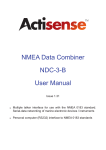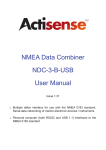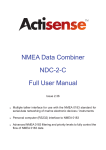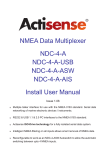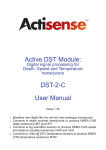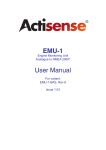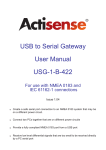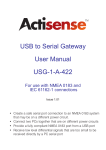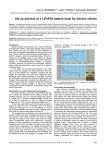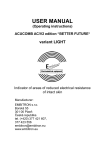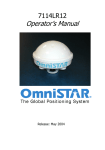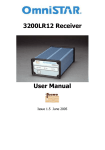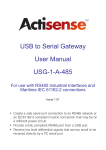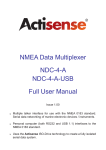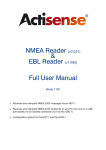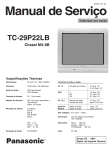Download NBF-1 User Manual Issue 1.30
Transcript
NMEA Buffer NBF-1-B User Manual Issue 1.30 Galvanically Opto-isolated NMEA 0183 data input for complete isolation between input and outputs. 4 NMEA 0183 (RS422 / RS485) data standard outputs capable of driving at least 8 NMEA 0183 instruments each. 2 NMEA 0183 (RS232) data outputs for compatibility with new and old NMEA instruments, and computer RS232 ports. NMEA Buffer - NBF-1-B Contents Important Notices Notices Foreword Introduction NMEA 0183 Introduction 4 4 4 4 5 Technical features Connecting devices together 5 6 Connections Input Connections 7 8 Output Connections 9 Electrical specifications The basics The NMEA signals The different NMEA standards NMEA 0183 Input Connecting to the battery supply NMEA 0183 / RS422 Outputs NMEA 0183 / RS232 Outputs Troubleshooting guide Specifications Company Information © 2005 Active Research Limited 5 6 6 6 8 8 9 9 10 11 12 Page 3 Actisense™ Important Notices Foreword The Actisense™ NMEA Data Combiner (NBF-1) is intended for use in a marine environment, primarily for below deck use. If the unit is to be used in a more severe environment, such use may be considered misuse under the seller’s warranty. Actisense™ recognises that instructions are often skipped, so we have aimed to write this document in an informative, yet direct manner that will aid the user. We have tried to cover all the points a typical user may need to know. Please read all sections before installing and using the Actisense™ NMEA Buffer product and any related software programs. The Actisense™ NMEA Buffer (NBF-1) has been certified to comply with the European directive for Electro-Magnetic Compatibility (EN60945), and is appropriately CE marked. Operation of the unit should be in conjunction with appropriate CE approved shielded connectors and cabling used in accordance with the CE directive EN60945. Any EMC related issues should be reported to Active Research immediately to allow the company to rectify or resolve EMC related problems in accordance with its obligations under EN60945. If the unit is connected such that compliance failure occurs beyond the company’s control, the company shall not be held responsible for compliance failure until suitable EMC guidelines for connection are seen to have been taken. Notices When using this document, keep the following in mind: The products described in this manual and the specifications thereof may be changed without prior notice. To obtain upto-date information and/or specifications, contact Active Research Limited or visit the Actisense™ website (www. actisense.com). Active Research Limited will not be liable for infringement of copyright, industrial property right, or other rights of a third party caused by the use of information or drawings described in this manual. All rights are reserved: The contents of this manual may not be transferred or copied without the expressed written permission of Active Research Limited. Introduction The Actisense™ NMEA Buffer (NBF-1) product was developed to solve a common problem: wanting to share the NMEA information from an NMEA device with more than two other NMEA instruments. Most NMEA output’s (e.g. GPS) can only drive 1 or 2 NMEA devices, any more and the signal becomes degraded and corruption of the NMEA data occurs. The Actisense™ NMEA Buffer solves all NMEA buffering problems by allowing distributed buffering of one NMEA instrument’s data output to a large number of other NMEA device inputs, and if required, even a PC’s RS232 port. Utilising fourteen years of experience in the marine industry in creating market leading depth sounders and other NMEA products, Actisense™ recognised the need to produce a full galvanic Opto-isolated, dependable NMEA buffering solution that meets, and indeed surpasses, all of the NMEA 0183 requirements. Alternately, if the vessel has two or more NMEA devices that are supplying the NMEA information, the system solution could be to use the Actisense™ NMEA Data Combiner (NDC-2 or NDC-3). Full information on the complete Actisense™ product range can be found on the Actisense™ website. Active Research Limited will not be held responsible for any damage to the user that may result from accidents or any other reasons during operation of the user’s unit according to this document. The NBF-1 does not validate the NMEA data it receives in any way. Neither the NMEA sentence checksum, nor the data contained within the NMEA sentence is validated. Therefore, the electronic device(s) supplying the NBF-1 with NMEA data retain(s) the sole responsibility for the NMEA data’s validity. © 2005 Active Research Limited Page 4 NMEA Buffer - NBF-1-B NMEA 0183 Introduction Designed over 20 years ago, the NMEA 0183 standard has slowly become the common method by which marine electronics devices talk to one another. The standard specifies both the electrical connections that make up an NMEA system and the format of the data sentences that carry the NMEA information. The NMEA 0183 standard is a purely digital data transmission scheme, using ‘1’s and ‘0’s in a binary format, to communicate a digital representation of the required information (depth, speed etc.) to connected instruments. Electrical specifications The latest specifications for NMEA0183 (version 2 onwards) are similar to the RS422 standard. They use +5v and 0v signalling, which is low voltage and can be interfaced to computer equipment (with an Actisense™ Opto-isolated adapter cable). In older equipment (version 1) however, voltage levels could be much greater (up to +/- 15v) as the original specification used 12-15 volt +/- signalling, which is similar to the standard RS232 computer communication ports. The NMEA 0183 specification also requires that all receiving equipment must be Opto-isolated; this Optoisolation requirement reduces the chances of interference and removes the problem of ground loop effects. Technical features The NMEA 0183 input is a full galvanic opto-isolated differential input to fully comply with the NMEA 0183 standard specification. This allows the input to work correctly with long cable runs and in a noisy environment. Typical operating voltage is 2.0v to 15.0v. The unit can withstand +/- 35v continuously, and +/- 40v transients. The Opto-isolator can protect any upstream equipment (chart plotter, laptop PC, radar etc.) from up to 2000v of common mode voltage difference. 2 NMEA 0183 / RS232 data output drivers. These outputs have a typical drive capability of 2 NMEA devices each. They offer extra compatibility with older NMEA instruments and standard computer communication ports, as well as still being fully compatible with the latest NMEA 0183 standard devices. Wide battery input voltage range to offer maximum compatibility, the NMEA 0183 Buffer NBF-1 can operate from a battery supply anywhere between 8 and 35 volts. Very low power consumption that is typically 6mA with no load and 70mA with all 6 outputs loaded (on a 12 volt system). This normally reduces to 4mA and 36mA respectively on 24 volt systems. Very tough Polycarbonate case is certified to IP66 (classified as “totally protected against dust and protection against low pressure jets of water from all directions”). Being Polycarbonate, it is also incredibly strong, offering a wide temperature range and superior protection to the electronics inside. The IP66 rating of the case is only limited by the sealing gasket strip, which can be enhanced by applying a suitable non-acid based marine sealant to the gasket after wiring and testing. This will allow use of the unit in areas where salt spray could enter, accidental immersion may occur, or in environments where maximum long-term reliability is paramount. Robust ABS grommets are certified to IP68 (classified as immersible for long periods without water ingress). Note that to achieve this level of water integrity all grommets must be occupied by round-section cables. Large range of possible cable diameters of between 4.5 mm and 10 mm, single or multi-pair wire types can be easily accepted. Removes all problematic ground loops between the NMEA device connected to the NBF-1 input port, and all the NMEA devices connected to the output ports. 4 NMEA 0183 full-differential output drivers. These outputs can drive up to 16 fully compliant NMEA 0183 device loads, with a 32 mA (maximum) drive capability. In practice, due to a lack of NMEA compliancy, this can reduce the maximum drive capability down to 8 NMEA devices. The full-differential output ensures better quality communications and lower noise emissions on unshielded twisted pair cabling. © 2005 Active Research Limited Page 5 Actisense™ Connecting devices together The basics NMEA data is transmitted from an information source such as GPS, depth sounder, gyro compass etc. These data sending devices are called “Talkers”. Equipment receiving this information such as a chartplotter, radar or NMEA display is called a “Listener”. Unfortunately, only one Talker can be connected on to a single NMEA 0183 system at any one time. Two or more Talkers are simply not possible because they are not synchronised to each other, and will attempt to ‘talk’ at the same time (over each other), resulting in corruption of the NMEA data, and potentially in disaster if valuable data such as navigation information is lost or corrupted so that it is incorrect and/or misleading. This fundamental problem with the NMEA system can be easily overcome, and multiple Talkers connected together, using the Actisense™ NMEA Data Combiner / Multiplexer (NDC-2 and NDC-3). If the required system has multiple NMEA Talker device of the same type (e.g. two GPS units), the highest priority device can be automatically switched using the Actisense™ Autoswitch (NSW-1). Please visit the Actisense™ website for full details on these and other Actisense™ products. The output drive capability of many instruments means that often their NMEA outputs can only drive one or two Listeners. In this case, the output of the Talker can be boosted to ‘talk’ to (a typical maximum of) 36 listeners simultaneously using the Actisense™ NMEA Buffer. The NMEA signals The NMEA 0183 system v2.0 and later uses a ”differential” signalling scheme, whereby two wires are used to transmit the NMEA data. These connections will be labelled as either NMEA “A” and “B“ or NMEA “+” and “-“ respectively, depending on the instrument and manufacturer. When connecting between different manufacturers, there can be some confusion, but it is simple and easy to remember: NMEA “A” connects to NMEA “+” and NMEA “B“ connects to NMEA “-“. The different NMEA standards The NMEA 0183 specification has slowly evolved over the years, so connecting one device to another is not always a straight forward matter. The earlier versions of NMEA 0183 (before v2.0, as detailed above), used slightly different connection methods and signal levels: the instruments had just one “NMEA” data line (‘Tx’ or ‘Out’), and used the ground as the other line - similar to the way a computer serial port works. This connection method is referred to as “single ended” instead of the “differential” method used by NMEA 0183 v2.0 devices. The data format is largely the same between both systems, with v2.0 adding some extra sentence strings, and removing older (redundant) sentence strings from the specification. The situation is further complicated, as many manufacturers still use the old (“single ended”) method of connection because it is cheaper to implement. So how can an older type NMEA device be connected to a newer type device? Care is needed – it is possible to damage or overload the output of a newer differential device if it is incorrectly connected to an older device. This is because the older devices used ground as the return, whereas the newer devices actually drive the NMEA “-/B” line between 5v and 0v. Thus, connecting this output to ground will result in high currents being drawn by the driver instrument, resulting in potential overheating and damage to the driver circuits. To connect a new type differential device to an old type single-ended system, connect the NMEA “+/A” output from the differential driver to the single-ended NMEA “Rx” or “In” input of the device. Leave the NMEA “-/B” output floating. Connect the ground line of the differential output device to the ground of the single-ended device. This provides the required data signal return current path. To connect an old type single-ended device to a new type differential device, connect the NMEA ”Tx” or “Out” output from the single-ended driver to the differential NMEA “+/A” input of the device. Connect the ground line of the single-ended output device to the NMEA “-/B” input of the differential device. This provides the data signal return current path. If the NMEA “-/B” input is left floating, then data corruption / errors may occur. Please refer to the Output Connections section for example of these connection methods. © 2005 Active Research Limited Page 6 NMEA Buffer - NBF-1-B Connections NMEA BUFFER 99999 NBF-1-B Figure 1 – All external connections The NMEA Buffer (NBF-1) has screw-terminal “Phoenix” type external connections for: 1. An NMEA 0183 input. The NMEA 0183 input is of the differential optoisolated type and uses the unique Actisense™ low current drain circuitry (2mA @ 2.0v) to conform in full with the NMEA 0183 marine electronic device network communication standard, and is flexible enough to interface to most full and partially compliant devices. Note: 1. To complete the NMEA 0183 standard all device interconnection NMEA cables used should meet the two-conductor, shielded, twisted pair configuration specification. The shield connection of these wires should be connected at the instrument end only to prevent ground loops. 2. 4 NMEA 0183 / RS422 outputs. Each NMEA 0183 / RS422 output comprises of two connections: ‘+/A’ and ‘-/B‘, and conforms in full to the NMEA 0183 standard. 2. Refer to the Specifications section for the full details on input/output specifications. 3. 2 NMEA 0183 / RS232 outputs. Each NMEA 0183 / RS232 output comprises of two connections: ‘Tx’ and ‘GND‘, and conforms in full to the NMEA 0183 standard. 4. Battery supply input. © 2005 Active Research Limited 3. If the laptop / PC to be used with the NBF-1 does not have an RS232 serial port available, the Actisense™ USB to RS232 adapter cable has been tried and tested to provide a compatible communications port. Please visit the Actisense™ website for full details on this, and other Actisense™ products. 4. Higher quality cable will naturally yield higher performance / higher Signal-to-Noise Ratio (SNR). Page 7 Actisense™ � � ��������� ������������ � � 99999 NMEA B Input Connections � � �� � ���� ���� �������� �������� �������� �������� Figure 2 – Input connections NMEA 0183 Input The NMEA 0183 differential opto-isolated input is designed to handle a variety of NMEA 0183 device output specifications. Please determine (from device manufacturer’s information) if the device required to be connected to the Actisense™ NBF-1 conforms in full to the NMEA 0183 network communication standard. If it does not, the flexible Actisense™ NBF-1 inputs should still be capable of interfacing with the device, though this is not guaranteed. The diagram (figure 2) above shows a typical installation with both fully compliant NMEA devices with differential outputs, and non-differential devices that output NMEA using the ground line as the “NMEA -” line. Please note that only one NMEA device can be connected to “NMEA IN” at any one time. NMEA Talker device A: This device conforms in full to the NMEA 0183 standard and shares the same connection ID’s as the Actisense™ NBF, so connection is a simple matter of matching ID’s (refer to figure 2). Personal Computer: A PC’s RS232 output may be directly connected to the NBF, allowing a PC to drive many NMEA instruments from its RS232 port without risk of damage or overload. Simply connect the PC’s “Tx” pin (Pin 3 on 9-pin D-type connector) to the NBF’s “+/A” and its “Ground” (Pin 5 on D-type) to the “-/B”. Connecting to the battery supply The Actisense™ NBF-1 should be wired to the vessel’s battery supply in the most direct manner possible, to minimize interference from other electronic devices. The cable used should be of sufficient gauge to handle the power requirements of the Actisense™ NBF-1 (refer to the Specifications sections). Note: 1. Wire colours are for guidance only. NMEA Talker device B: This is a single ended (nondifferential) device and does not conform completely to the NMEA 0183 standard. However, by connecting ‘+‘ to ‘+/A‘ and its ‘G/Ground’ to the NBF “-/B”, the NBF should be able to receive the NMEA data correctly. © 2005 Active Research Limited Page 8 NMEA Buffer - NBF-1-B Output Connections �������� �� �������� � � � ���� ���������� � ���� ���������� � � ���� ���������� ���� ���������� � � � � ���� � ���������� � � � ���� ���������� � ���� ���������� NMEA BUFFER 99999 NBF-1-B Figure 3 – Output connections NMEA 0183 / RS422 Outputs The NMEA 0183 / RS422 buffered outputs are capable of driving up to 16 fully NMEA 0183 compliant listening devices each. In practice, however, this can be reduced down to 8 listening devices per output. Figure 3 shows only one device per output to simplify the diagram. NMEA Listener device’s 1, 2 and 4: These devices conform in full to the NMEA 0183 standard and their connection ID’s match that of the NBF-1. Simply connect like for like (“+” to “+”, “A” to “A” etc.). NMEA Listener device 3: This device does not conform in full to the NMEA 0183 standard and is a single-ended device. Connection of single-ended devices to a differential output must be done with caution. Connect device’s ‘+‘ to the NBF’s ‘+/A‘, and its ‘G/Ground’ to an RS232 output ‘Gnd’. Listener device 3 should now be able to receive the NMEA data correctly, though this is not guaranteed. The NBF’s “-/B” must never be connected to the ground of a single-ended receiving instrument. The resulting extra load may in the worst case damage the output driver. Personal Computer: Whilst the RS232 outputs are primarily designed for connection to a PC, most PC’s are capable of reading the NMEA 0183 outputs as well. Simply connect ‘+’ to ‘Rx’ and ’G’ to ‘Gnd’ on a standard D-type (probably male) connector. © 2005 Active Research Limited NMEA 0183 / RS232 Outputs The RS-232 outputs can be connected to a PC‘s communication port, older NMEA devices, as well as the very latest NMEA instruments. NMEA Listener devices 6 and 7: These devices conform in full to the NMEA 0183 standard. Simply connect the devices “+” or “A” to the NBF’s “Tx” and the devices “-” or “B” to the NBF’s “Gnd”. NMEA Listener device 5: This device does not conform in full to the NMEA 0183 standard and is a singleended device. However, the flexible outputs of the NBF should be able to drive this device if the device’s “+” is connected to the NBF’s “Tx” and its “G/Ground” to the NBF’s “Gnd”. Personal Computer: The RS232 outputs are the preferred output for connection to a PC. Connect PC’s ‘Rx’ (Pin 2 on a standard 9-Pin D-type) to NBF’s ‘Tx’ and its ’G/Ground’ (Pin 5 on D-type) to ‘Gnd’. Note: 1. Wire colours are for guidance only. Page 9 Actisense™ Troubleshooting guide This guide will concentrate on all relevant troubleshooting issues above simple cable connection faults. Therefore, the cables between the NBF-1 hardware and any other devices should be checked as a matter of course, before continuing with this guide. Problem / Error condition Required user response Ensure that correct polarity of the NMEA connections have been observed - NMEA connections are polarity sensitive. No data seen on NMEA instrument display “+” and “A” connections should be wired to the NBF’s “+/A”. “-” and “B” connections should be wired to the NBF’s “-/B”. No damage should be caused if the polarity is reversed, but no NMEA data will be seen on the receiving instrument. Ensure that the PC software is selecting the correct PC Comms port number. No data seen on PC display As a diagnostic, you can use the standard Windows “HyperTerminal” utility to receive NMEA data. By setting the input comms port to the one the NMEA NBF-1 is connected to, the baud rate to that required (4800 normally), no parity, 1 stop bit, 8 data bits and no flow control, the received NMEA text data from the NBF-1 will be shown on the PC screen. Table 1 – Troubleshooting guide © 2005 Active Research Limited Page 10 NMEA Buffer - NBF-1-B Specifications Parameter Conditions Min. Max. Unit 8 35 V Supply voltage = 12v 6 70 mA Supply voltage = 24v 4 36 mA -15.0 0.5 V 4.0 15.0 V 2.0 30 mA 1.8 2.0 V 0.0 0.5 V 4.8 5.2 V - 32 mA 50 55 mA 38.4 Kbit/sec ±9 V Supply Supply voltage Supply current (see note 1) NMEA 0183 / RS422 Input voltage between +/Input current Differential input voltage Output voltage between +/- and ground (see note 2) Output current (see note 2) Logical ‘1’ / stop bit Logical ‘0’ / start bit Maximum is under +35v overload condition Required level for NMEA to be detected Logical ‘1’ / stop bit At maximum load, drive voltage reduces to 2v Output short circuit current. Baud rate NMEA 0183 / RS-232 Output voltage swing Loaded with 3κΩ to Ground ±5 Output resistance Output short circuit current (Infinite duration) Baud rate (RS232 Vout = ±2v) 300 Data propagation delay Ohms ±18 mA 38.4 Kbit/sec 1.0 100 ms -20 +70 °C General Ambient temperature Table 2 – NBF-1 specifications All specifications are taken with reference to an ambient temperature (TA) of +25°C. Note: 1. Current consumption measured under no-load and full-load conditions 2. NMEA output is RS-485 compatible. © 2005 Active Research Limited Page 11 Actisense™ Company Information Active Research Limited 5, Wessex Trade Centre Ringwood Road Poole Dorset UK BH12 3PF Telephone: Fax: 01202 746682 (International : +44 1202 746682) 01202 746683 (International : +44 1202 746683) Actisense™ on the Web: For advice, support and product details E-mail: Website: [email protected] www.actisense.com Active Research on the Web: For specialist consultancy and customisation E-mail: Website: [email protected] www.activer.com © 2005 Active Research Limited Page 12












